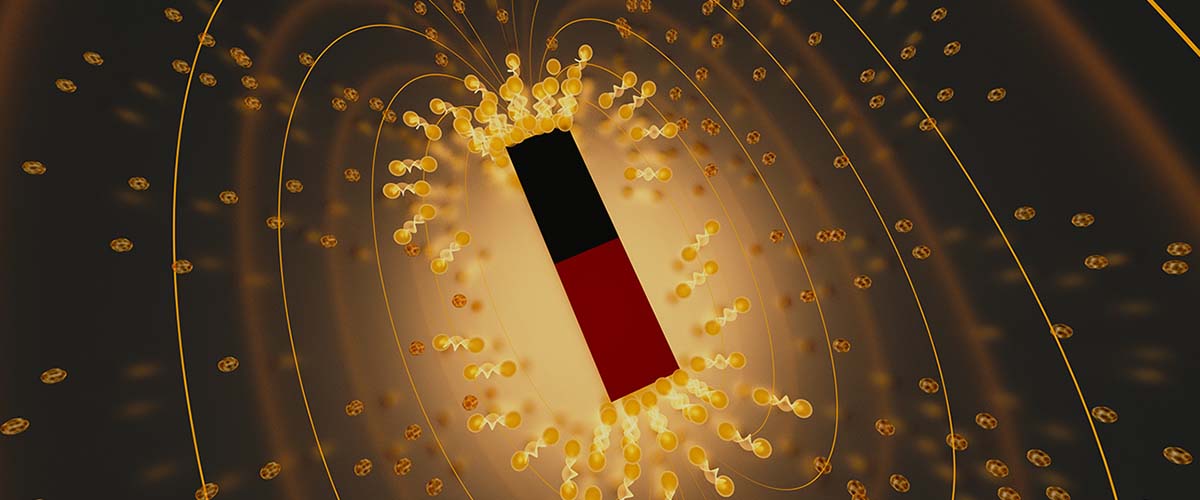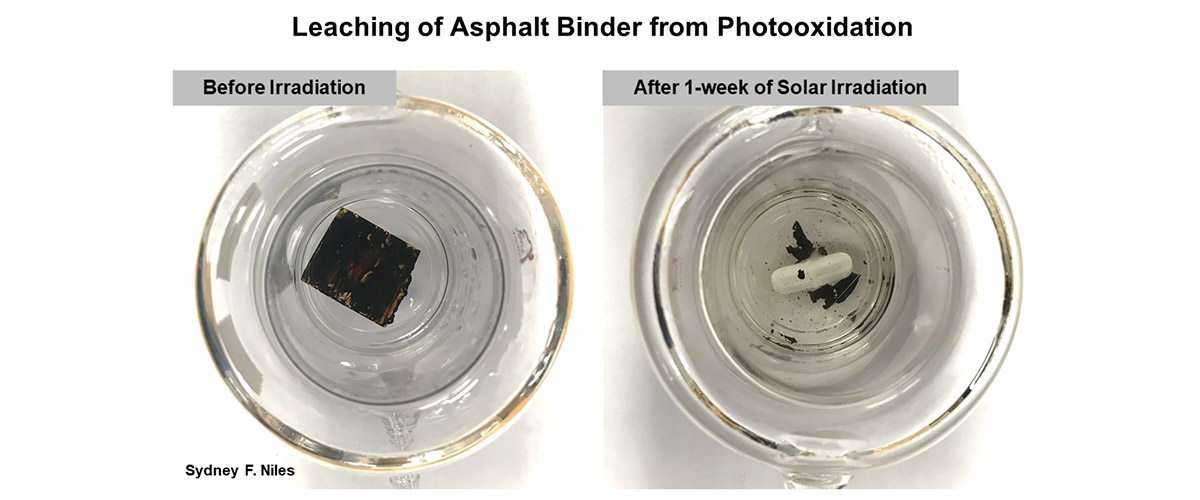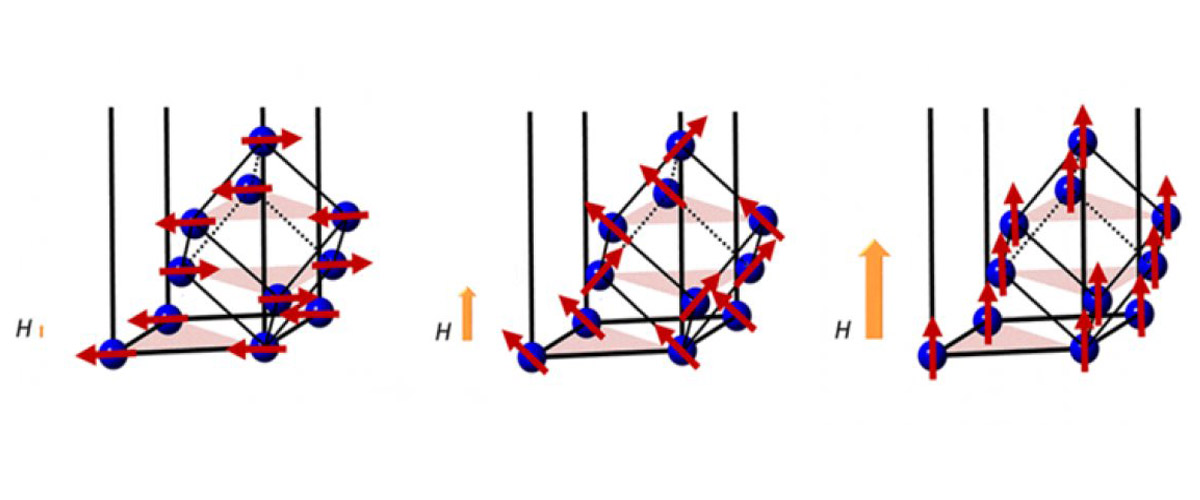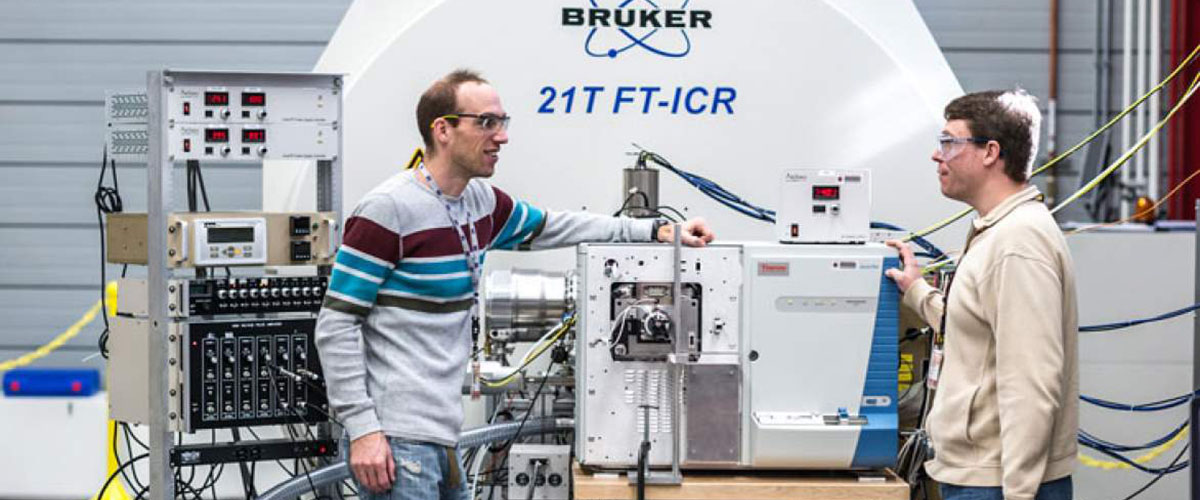The first shoe landed last month when, in a paper published in Science, Butch announced the discovery that UTe2 exhibited special properties that were exciting both for the new physics they illustrated and their potential use in quantum computers.
His team, which included researchers from the University of Maryland and the National MagLab, had observed a special kind of superconductivity, which is a state in which electrons travel through a material with perfect efficiency. (In copper, by contrast, roughly 20% of power is lost over long-distance transmission lines because the electrons bump around a lot as they advance.) The rarity of the behavior the scientists found, known as spin-triplet superconductivity, suggested that they had seen but the tip of the UTe2 iceberg.
With today’s shoe-drop, that suspicion is confirmed. In an article published in Nature Physics by another Butch-led team working at the National MagLab, a bigger chunk of that iceberg has risen to the surface.
In fact, it could be said to have risen from the dead: The team found that the high magnetic fields that destroy the superconducting state in the vast majority of materials appeared, under certain conditions, to bring it back to life in UTe2, a Lazarus-like effect called reentrant superconductivity. And the team observed this “Lazarus superconductivity” not just once, but twice.
“This is a very recently discovered superconductor with a host of other unconventional behavior,” said Butch. “So it's already weird.”
The new twist of Lazarus superconductivity, he added, is hardly random. “It almost certainly has something to do with the novelty of the material,” Butch said. “There's something different going on in there.”
That “something” might still be hidden, had Butch not turned a science lemon into lemonade.
Butch's UTe2 windfall is something of a fluke: His team synthesized the crystal accidentally while trying to make another uranium-based compound. They decided to take a look, anyway, even though previous research on the compound hadn’t yielded anything unusual (see sidebar).
But the more they looked, the more they liked. In Science they reported that UTe2’s superconductivity involved an unusual electron configuration called spin triplets, in which pairs of electrons are aligned in the same direction. In the vast majority of superconductors, the orientation (referred to as “spins”) of paired electrons point in opposite directions, called singlets. Magnetic fields can easily disrupt singlets, killing superconductivity. Spin triplet superconductors , however, can withstand much higher fields.
Butch’s early findings led him to the National MagLab, a user facility funded by the National Science Foundation (DMR-164479) and the State of Florida. Using the lab’s unique combination of very high-field magnets, instrumentation and expertise, his team could push UTe2 even further.
In a way, Butch was bringing the material into the lion’s den. Magnetic fields interact with electrons and, when strong enough, bust apart the electron pairs that are responsible for superconductivity, giving physicists important information about the material’s behavior that may inspire new technological devices.
At the MagLab, the team tested the material in some of the highest magnetic fields available (up to 65 teslas, more than 30 times the strength of an MRI magnet) at the lab’s DC Field Facility at Florida State University and its Pulsed Field Facility at Los Alamos National Laboratory. Their goal: to see at which point the fields crushed superconductivity. In addition to strong magnets and frigid temperatures (most superconductors perform only when quite cold), Butch and his team introduced a third parameter: They oriented the UTe2 crystal at specific angles vis-à-vis the direction of magnetic field.
In addition to the superconductivity they had observed at lower fields, they discovered two different kinds of reentrant superconductivity that surfaced at specific angles and even higher magnetic fields.
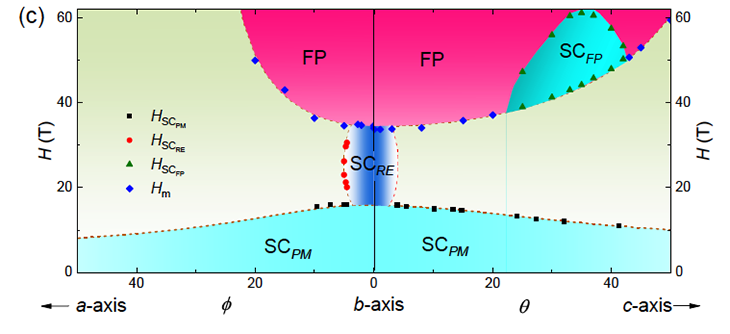
This diagram depicts the different kinds of superconductivity Butch's team discovered in uranium ditelleride under varying magnetic fields and angles.
Image courtesy of Nick Butch
Image courtesy of Nick Butch
At about 16 teslas, the material’s superconducting state abruptly changed: While it died in most of the experiments, it persisted when the crystal was aligned at a very specific angle in relationship to the field. This behavior continued until about 35 teslas. At that point, not only did all superconductivity vanish, but the electrons shifted their alignment in the field, entering a new magnetic phase.
But UTe2 had yet another trick up its sleeve. As the researchers ramped the field even higher while continuing to fiddle with angles, they found that a different orientation of the crystal to the field yielded yet another superconducting phase, this one persisting to at least 65 teslas, the maximum field tested. It was a record-busting performance for a superconductor and an unprecedented finding: the first time two field-induced superconducting phases have been found in the same compound. Instead of killing superconductivity, high fields appeared to stabilize it.
While it’s not yet clear exactly what is happening at the atomic level, Butch said the evidence points to a phenomenon fundamentally different than anything scientists have seen to date.
“I'm going to go out on a limb and say that these are probably different — quantum mechanically different — from other superconductors that we know about,” Butch said. “It is sufficiently different, I think, to expect it will take a while to figure out what's going on.”
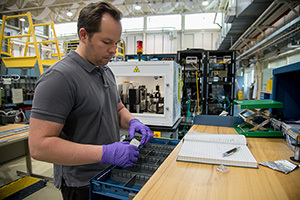
Nick Butch
Image Credit: F. Webber/NIS
The pace of the hunt has quickened now that, as word on Butch’s intriguing discoveries has spread, scientists around the world have launched their own studies into uranium ditellerude — the sincerest form of science flattery.
At the National MagLab, Director Greg Boebinger is among those predicting that scientists will be drawing from the UTe2 well for many years to come.
“The discovery of this ‘Lazarus superconductivity’ at record-high fields is likely to be among the most important discoveries to emerge from this lab in its 25-year history,” said Boebinger. “I would not be surprised if unraveling the mysteries of UTe2 leads to even stranger manifestations of superconductivity in the future.”
On top of its convention-defying physics, UTe2 shows every sign of being a topological superconductor, as are other spin-triplet superconductors, Butch said. Its topological properties suggest it could be a particularly accurate and robust component in the quantum computers of the future.
“Maybe,” Butch ventured, “down the road, we're going to be making devices out of this.”
Sounds like we should all keep an ear out for dropping shoes.
The research paper, "Extreme magnetic field-boosted superconductivity," Sheng Ran, I-Lin Liu, Yun Suk Eo, Daniel Campbell, Paul Neves, Wesley Fuhrman, Shanta Saha, Christopher Eckberg, Hyunsoo Kim, Johnpierre Paglione, David Graf, Fedor Balakirev, John Singleton and Nicholas Butch, was published in the journal Nature Physics on October 7, 2019.
Read more in DC Field - Pulsed Field Science Highlight.
Story by Kristen Coyne



